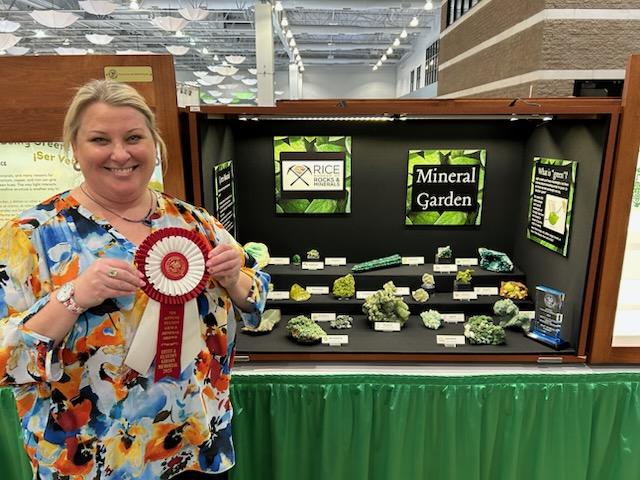Green Gems galore
Rice Museum’s Triumph at Tucson 2025 We are thrilled to announce our recent success at the 70th Annual Tucson Gem & Mineral Show, where we proudly took home the Betty and Clayton Gibson Memorial Trophy for Best Museum Exhibit. This year’s theme, “Shades of Green – Experience the Magic,” provided the perfect backdrop for our stunning display of verdant minerals. Our Award-Winning Exhibit: Our exhibit showcased a breathtaking array of green minerals, each with its unique charm and characteristics, including: Malachite: This iconic green mineral, known for its striking banded patterns, captivated visitors with its rich, forest-green hues. Prehnite: Our collection featured exquisite specimens of this pale green to yellow-green mineral, prized for its subtle beauty and spiritual properties. Dioptase: The deep emerald-green crystals of dioptase were a highlight, their intense color rivaling that of emeralds. Austinite: This rare arsenate mineral, with its delicate mint-green crystals, added a touch of elegance to our display. Austinite. Ojuela Mine, Mapimi, Mun. de Mapimi, Durango, Mexico. The Magic of Green Minerals Green minerals have long fascinated collectors and enthusiasts alike. They evoke memories of lush landscapes and symbolize nature, spring, and renewal. The variety of green hues in the mineral world is truly astounding, ranging from the electric lime of pyromorphite to the deep forest green of malachite. What is “green”? Light is made up of many wavelengths, but these minerals absorb everything except for green. So our brains see that wavelength and say, “yep,that’s green!” But, about 350 million people don’t see all wavelengths of the light spectrum and instead of shades of greens, might be seeing colors like orange, red, yellow, beige, brown, or blue in this display. How cool is that? What are some things that make minerals green? Physical material. For example, green clay. Structures that affect how a mineral absorbs or reflects light. For example, green flash in opal. Elements that are part of the mineral’s structure. For example, the copper (Cu) in Malachite’s chemical formula. Chemical impurities. For example, when beryl contains Chromium (Cr), it is called an emerald. Prehnite with epidote. Sadiola Gold Mine, Sadiola hill, Kayes Region, Mali. Collector’s Corner For mineral enthusiasts looking to start or expand their green mineral collection, here are some tips: Research the hardness and durability of minerals before purchasing. Consider the rarity and origin of specimens to build a diverse collection. Look for unique crystal formations or patterns that make each piece special. Invest in proper storage and display options to protect and showcase your collection. Malachite ‘Corn on the Cob’. Looking Ahead The success of our exhibit at the Tucson Gem & Mineral Show has inspired us to continue our mission of educating and inspiring the public about the wonders of the mineral world. We invite you to visit the Rice Museum of Rocks and Minerals to experience our award-winning collection firsthand and discover the magical world of green minerals for yourself.


